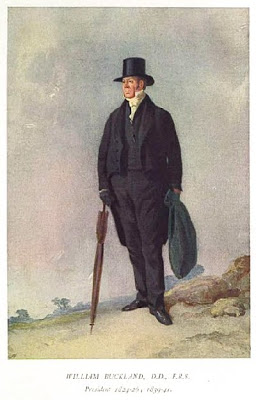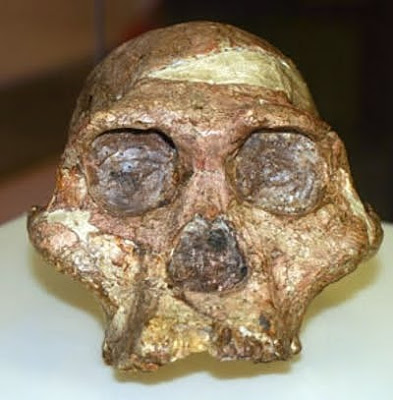Philosophy
 William Buckland
William Buckland
March 12th, 1784 to August 14th, 1856
William Buckland has the distinct honors of being the first professor of geology in England [Oxford, 1818] and the discoverer of the first dinosaur bones [Megalosaurus bucklandii].
Wikipedia...
...at the Stonesfield quarry (currently considered part of the Taynton Limestone Formation, dating to the mid-Bathonian stage of the Jurassic Period). They were acquired by William Buckland, Professor of Geology at the University of Oxford and dean of Christ Church. He did not know to what animal the bones belonged but, in 1818, after the Napoleonic Wars, the French comparative anatomist Georges Cuvier visited Buckland in Oxford and realised that the bones belonged to a giant lizard-like creature. Buckland then published descriptions of the bones in Transactions of the Geological Society, in 1824 (Physician James Parkinson had described them in an article in 1822).
By 1824, Buckland had a piece of a lower jaw with teeth, some vertebrae, and fragments of pelvis, scapula and hind limbs, probably not all from the same individual. Buckland identified the organism as being a giant animal related to the Sauria (lizards) and he placed it in the new genus Megalosaurus, estimating the animal to be 12 m long in life. In 1826, Ferdinand von Ritgen gave this dinosaur a complete binomial, Megalosaurus conybeari, which was not used by later authors and is now considered a nomen oblitum. A year later, in 1827, Gideon Mantell included Megalosaurus in his geological survey of southeastern England, and assigned the species its current binomial name, Megalosaurus bucklandii. It would not be until 1842 that Richard Owen coined the term 'dinosaur'.
The caves and a nation's identity...

Bill Ashworth [Linda Hall Library Newsletter] wrote...
At Kirkdale Cave in Yorkshire, he found bones with teeth marks on them, which he was able to match up with the jaws of hyenas, suggesting that the cave was once a hyena den. At Paviland cave, in southern Wales, he found not only the remains of a mammoth, but a human skeleton, covered in red ochre. Since humans and mammoths were not thought at that time to be contemporary, Buckland concluded that the skeleton was that of a local Celtic woman, who lived there at the time of the Roman occupation of Wales, and perhaps plied her wares in the Roman camp nearby. The "Red Lady of Paviland," as she came to be called, has recently generated a great deal of interest, especially among the Welsh, for who she has become a national icon, and we now know that the Lady was actually an Upper Paleolithic male who lived in the area about 26,000 years ago, making her (him) the oldest known early modern human in the British Isles.
William Buckland
- The "water Nymph" Of The Yucatan Peninsula
The find has been named Naia, Greek for "water nymph". "Pristine prehistoric skeleton of teenage girl found in underwater cave" by Sheryl Ubelacker May 16th, 2014 CTV News The pristine skeleton of a teenaged girl who lived about 13,000 years ago, discovered...
- Gruesome Dwarf Herbivores...the Pegomastax
"Bizarre Species of Miniature Dinosaur Identified" by John Noble Wilford October 3rd, 2012 The New York Times Not every dinosaur grew up to be a mighty predator like Tyrannosaurus rex or a hulking vegan like Apatosaurus. A few stayed small, and some...
- 19th Century Fossil Woman--mary Anning
Mary Anning May 21st, 1799 to March 9th, 1847 She is credited with the first discovery of an ichthyosaur skeleton and a fantastic collector of Jurassic era marine fossils. University of California Museum of Paleontology... Despite the fact that Mary...
- Bambiraptor Purloined For Bucks
This is not good, but not new. Remember Sue the T. Rex? Sue Hendrickson, amateur paleontologist, discovered the most complete (more than 90%) and, until 2001, the largest, Tyrannosaurus fossil skeleton known in the Hell Creek Formation near Faith, South...
- Good Science Among Paleontologists
This is a healthy approach to a recently discovered find regarding 65+ million year old dinosaur tissue. "Scientists question dinosaur soft tissue find" by Maggie Fox July 29th, 2008 Reuters Soft tissue taken from preserved dinosaur bones may not be...
Philosophy
William Buckland...Kirkdale/Paviland caves and "Red Lady of Paviland"
 William Buckland
William BucklandMarch 12th, 1784 to August 14th, 1856
William Buckland has the distinct honors of being the first professor of geology in England [Oxford, 1818] and the discoverer of the first dinosaur bones [Megalosaurus bucklandii].
Wikipedia...
...at the Stonesfield quarry (currently considered part of the Taynton Limestone Formation, dating to the mid-Bathonian stage of the Jurassic Period). They were acquired by William Buckland, Professor of Geology at the University of Oxford and dean of Christ Church. He did not know to what animal the bones belonged but, in 1818, after the Napoleonic Wars, the French comparative anatomist Georges Cuvier visited Buckland in Oxford and realised that the bones belonged to a giant lizard-like creature. Buckland then published descriptions of the bones in Transactions of the Geological Society, in 1824 (Physician James Parkinson had described them in an article in 1822).
By 1824, Buckland had a piece of a lower jaw with teeth, some vertebrae, and fragments of pelvis, scapula and hind limbs, probably not all from the same individual. Buckland identified the organism as being a giant animal related to the Sauria (lizards) and he placed it in the new genus Megalosaurus, estimating the animal to be 12 m long in life. In 1826, Ferdinand von Ritgen gave this dinosaur a complete binomial, Megalosaurus conybeari, which was not used by later authors and is now considered a nomen oblitum. A year later, in 1827, Gideon Mantell included Megalosaurus in his geological survey of southeastern England, and assigned the species its current binomial name, Megalosaurus bucklandii. It would not be until 1842 that Richard Owen coined the term 'dinosaur'.
The caves and a nation's identity...

Bill Ashworth [Linda Hall Library Newsletter] wrote...
At Kirkdale Cave in Yorkshire, he found bones with teeth marks on them, which he was able to match up with the jaws of hyenas, suggesting that the cave was once a hyena den. At Paviland cave, in southern Wales, he found not only the remains of a mammoth, but a human skeleton, covered in red ochre. Since humans and mammoths were not thought at that time to be contemporary, Buckland concluded that the skeleton was that of a local Celtic woman, who lived there at the time of the Roman occupation of Wales, and perhaps plied her wares in the Roman camp nearby. The "Red Lady of Paviland," as she came to be called, has recently generated a great deal of interest, especially among the Welsh, for who she has become a national icon, and we now know that the Lady was actually an Upper Paleolithic male who lived in the area about 26,000 years ago, making her (him) the oldest known early modern human in the British Isles.
William Buckland
- The "water Nymph" Of The Yucatan Peninsula
The find has been named Naia, Greek for "water nymph". "Pristine prehistoric skeleton of teenage girl found in underwater cave" by Sheryl Ubelacker May 16th, 2014 CTV News The pristine skeleton of a teenaged girl who lived about 13,000 years ago, discovered...
- Gruesome Dwarf Herbivores...the Pegomastax
"Bizarre Species of Miniature Dinosaur Identified" by John Noble Wilford October 3rd, 2012 The New York Times Not every dinosaur grew up to be a mighty predator like Tyrannosaurus rex or a hulking vegan like Apatosaurus. A few stayed small, and some...
- 19th Century Fossil Woman--mary Anning
Mary Anning May 21st, 1799 to March 9th, 1847 She is credited with the first discovery of an ichthyosaur skeleton and a fantastic collector of Jurassic era marine fossils. University of California Museum of Paleontology... Despite the fact that Mary...
- Bambiraptor Purloined For Bucks
This is not good, but not new. Remember Sue the T. Rex? Sue Hendrickson, amateur paleontologist, discovered the most complete (more than 90%) and, until 2001, the largest, Tyrannosaurus fossil skeleton known in the Hell Creek Formation near Faith, South...
- Good Science Among Paleontologists
This is a healthy approach to a recently discovered find regarding 65+ million year old dinosaur tissue. "Scientists question dinosaur soft tissue find" by Maggie Fox July 29th, 2008 Reuters Soft tissue taken from preserved dinosaur bones may not be...
